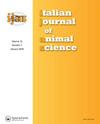Body measures, growth curves and body weight prevision of alpacas ( Vicugna pacos ) reared in Italy
IF 2.3
3区 农林科学
Q1 AGRICULTURE, DAIRY & ANIMAL SCIENCE
引用次数: 0
Abstract
Alpacas represent an exotic species for Italy, introduced no more than 20–30 years ago. Nevertheless, they are currently the most widespread camelid species reared in this country, highlighting the growing interest in breeding this species. So, it is useful to assess parameters on their growth in relation to the new environment. Thus, body weight and body measures were recorded on 49 healthy alpacas of Huacaya type (27 females, 22 males), along a period of 27 months. Overall, 111 individual observations were made. Data were analysed by ANOVA, as growth curves were estimated by applying the Gompertz’s model. Multiple regression was finally used to estimate body weight from body measures. Body weight and linear measures, except for the distance between iliac crest and the length of the rump, were influenced by the category (calves, yearlings, adults) and by the age class within category (p < 0.05), while gender and interaction between gender and category were never significant (p > 0.05). Asymptotic weigh of males was 8.25% higher than females (p < 0.05). Moreover, males at maturity had higher withers (+0.96%), longer body (+2.70%) and chest measurements (+3.18%) than females. Asymptotic rump width (both at the ilium and at the ischium) was higher in females (respectively + 6.19%; +12.90%). According to our work, the best equation for the estimate of body weight from body measures was the following: 5.691 + 0.00005624 * chest circumference3 + 0.00002298 * trunk length3 − 1.155 * rump width between ischial tuberosities + 0.00001545 * height at rump3 (R2=0.957; SE of estimate = 4.36 kg), that is important for a better management of the species.意大利饲养羊驼的体型测量、生长曲线和体重预测
羊驼对意大利来说是一种外来物种,在20-30年前引进。然而,它们是目前在这个国家饲养的最广泛的骆驼物种,这表明人们对繁殖这种物种的兴趣日益浓厚。因此,评估它们在新环境下的生长参数是有用的。为此,对49头华卡雅型健康羊驼(雌性27头,雄性22头)进行了27个月的体重测量。总共进行了111次个人观察。数据用方差分析分析,生长曲线用Gompertz模型估计。最后采用多元回归方法从体重测量中估计体重。除髂骨与臀长之间的距离外,体重和线性测量均受类别(犊牛、犊牛、成年)和类别内年龄类别的影响(p < 0.05),性别及性别与类别之间的交互作用不显著(p > 0.05)。男性的渐近体重比女性高8.25% (p < 0.05)。成熟期雄性的肩隆(+0.96%)、体长(+2.70%)和胸围(+3.18%)均高于雌性。女性的渐近臀宽(髂骨和坐骨)更高(分别为+ 6.19%;+ 12.90%)。根据我们的研究,用体尺估算体重的最佳公式为:5.691 + 0.00005624 *胸围3 + 0.00002298 *躯干长3 - 1.155 *坐骨结节间的臀宽+ 0.00001545 *臀高3 (R2=0.957;估计SE = 4.36 kg),这对更好地管理该物种很重要。
本文章由计算机程序翻译,如有差异,请以英文原文为准。
求助全文
约1分钟内获得全文
求助全文
来源期刊

Italian Journal of Animal Science
农林科学-奶制品与动物科学
CiteScore
4.90
自引率
8.00%
发文量
141
审稿时长
18-36 weeks
期刊介绍:
The Italian Journal of Animal Science is an international peer-reviewed open access journal publishing original scientific papers, reviews and short communications on animal science, animal production and related areas. The journal welcomes submissions on the following subjects:
• Animal derived food quality and safety
• Animal genetics and breeding
• Aquaculture, poultry, companion and wildlife
• Livestock systems, management and environment
• Non-ruminants nutrition and feeding
• Production physiology and biology
• Ruminants nutrition and feeding
Announcements of congresses, presentations of universities, research institutes, books and proceedings may also be published, as well as news regarding the members of the Animal Science and Production Association (ASPA). The Association will be glad to receive proposals for your admission as an ordinary or corresponding member: please read regulations and procedures in the statute of the ASPA .
 求助内容:
求助内容: 应助结果提醒方式:
应助结果提醒方式:


